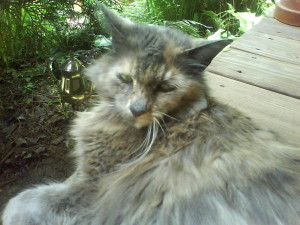(or: Why I Love Talking Animals)
I just finished writing a new song. Woo! But … it’s sung in the voice of my cat Sally:

(who, as you can see, is super fluffy and adorable.)
This is the second song I’ve written from the perspective of a cat this year. That’s more cat songs than I’ve written in all my previous years of songwriting combined, so I’m a little worried about my future. I really hope I don’t end up with an entire cat album (with me in a cat sweater on the cover).
But it’s a real risk, because I love first person narration, and my absolute favorite type of narrator is an animal or inanimate object. I’ve written songs narrated by everything from a hermit crab (“Shells”) to a black hole to a six pack of beer.
Sometimes, my songs with non-human narrators are straightforward, without much symbolic meaning. This is the case for my first cat song, “Frank of the A. H.,” which is a portrait the nastiest, most antisocial cat I have ever encountered. (Seriously, the things he did, which I subsequently wrote about, were so gross and horrible that I am afraid to post the song online.) This kind of narration is fun because it allows me to get outside my own head and imagine life from a totally different perspective.
Other times, my object-or-animal-narrated songs are metaphors. “Rusty Hook”, for example, is narrated by a fish (the Golden Fish, to be exact). The fish represents me, and the story represents my reaction to a super weak attempt of an ex-lover of mine to reconnect with me.
I used to worry about using animals or objects to represent myself or other women in songs, because women are so often objectified and treated as less than full and complex humans. I didn’t want to feed into the sexist tropes comparing women to things like bunnies, cars, or pieces of meat, or in any way encourage dehumanizing attitudes towards women.
But now I think non-human narrators can actually subvert this objectification. Giving a voice and agency to an object or animal forces listeners to see the humanity of an entity they initially considered sub-human. When I speak as an object or animal, it’s as if I’m saying, ok, maybe you think I’m a cat/car/boat/whatever it is you’re comparing me to these days, but I still have my own thoughts, feelings, and desires that you cannot silence, control, or contain. For me, writing songs with non-human narrators is a great way of responding to the limiting illusions others have about me.
“Rusty Hook” does just that. The fisherman thinks the fish is a simple animal, that he can drop a hook in the water and she will come. But the fish has agency: she has a lively underwater social life, she value herself (she has majesty), and she demands to be treated with respect before she will consider engaging with the fisherman again. I feel totally comfortable having her represent me in a song – she’s smart and independent, and not nearly as easy to control as the fisherman thinks!
My new song, “Sally’s Song,” combines the literal and metaphoric approaches to non-human narration. Everything in the song is true for my cat Sally, but her story is also a metaphor for me and my interpersonal relationships. Unfortunately, I don’t have a recording to share yet, since the song is only three days old, but I’ll post it as soon as I do!
Thanks for reading! I have another practice and recording session scheduled for tomorrow, and if all goes well, I’ll have new songs to share, so stay tuned!
One thought to “Am I Turning Into a Crazy Cat Lady?”
Pingback: One Easy Way to Capture Your Song Ideas (Before You Lose Them Forever!) | Pippa Hoover
Comments are closed.